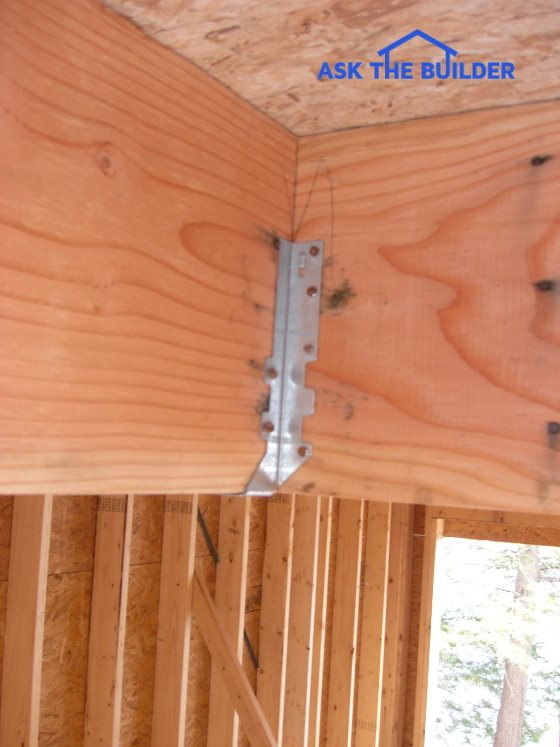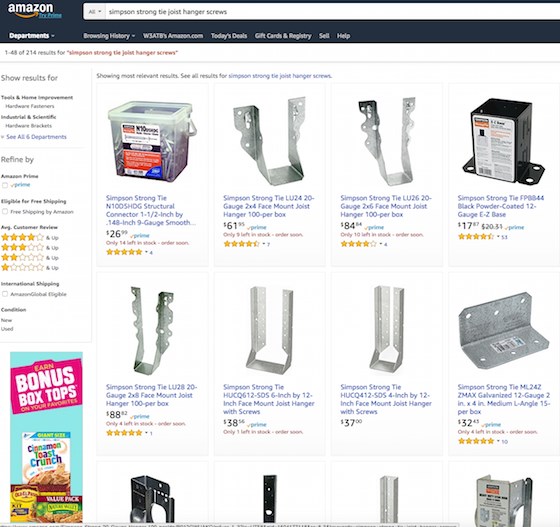Joist Hangers

Joist Hangers | This joist hanger is made from galvanized steel and can support a significant amount of weight when installed correctly. WATCH THE VIDEOS JUST BELOW. PHOTO CREDIT: Tim Carter
Joist Hangers TIPS
- Get new joist hangers approved for high-copper-content treated lumber
- Structural screws are better than nails
- WATCH joist hanger screws video below
- NEVER use roofing nails - they're deadly
- CLICK HERE to Get Tim's FREE & FUNNY Newsletter!
DEAR TIM: The carpenter that built my deck used joist hangers to hold up the joists along the house and at the end of the deck. Are these steel joist hangers approved and will they stand the test of time?
I’m worried that the joists will fall out of the hanger or pull away from the house. Is there a right and wrong way to install these framing connectors?
Is there a way to build without using joist hangers? Sally P., Richmond, IN
DEAR SALLY: If the joist hangers your carpenter used are approved for use with the newer ACQ treated lumber, you should have nothing to worry about.
The Weakest Link
These metal framing connectors have been around for years and they're code approved. The biggest problem I’ve seen with joist hangers of all types is using the wrong nails when installing them. The latest advice from the top metal framing connector manufacturer in the USA, Simpson Strong-Tie, is to use structural screws instead of nails.
Roofing Nails = Death On A Stick
All too often rookie carpenters or do-it-yourself homeowners will install joist hangers using roofing nails. That’s a recipe for disaster as roofing nails are not structural nails.
Roofing nails don’t have the inherent strength to support the weight of a deck or any framing member. Not only are the shafts of roofing nails too small, but the heads of roofing nails can also easily pop off when subjected to low amounts of tension.
Free & Fast Bids
Approved Thick Nails
Most of the manufacturers of high-quality joist hangers sell their own approved nails. Not only are the nails heavy duty, but they also have a special galvanized coating that’s designed to resist rust and corrosion from chemicals found in modern-day treated lumber.
I would have your carpenter show you the box that the nails came in to make sure they’re approved. The labeling should show that the nails are approved for outdoor use and have the level of protection on them.
Screws Are Best
The new advice to use screws instead of nails is simple. Over time nails can loosen and work their way out of the wood.
This happens because of the repeated wetting and drying of the treated wood. Wood is hygroscopic and expands and contracts when it gets wet and then dries out. If you use approved structural screws instead of nails, the screws will stay snug in the wood.
Joist Hanger Screw Video
I show you in this video the structural screws and how they go into a typical joist hanger.
Small Support Shelf
I can see why you might be concerned about the joists pulling away from the house. The small metal shelf or seat at the bottom of the hanger that each deck joist rests on seems insufficient. The truth be told, that’s plenty of support assuming that your deck is built correctly.
Diagonal Holes In Hanger
If your carpenter used high-quality decking joist hangers and the correct nails, you probably will have no problems. You should be able to see on the face of the joist hanger that’s on the actual joist several small holes. These holes are punched at an angle and are meant to accept 3-inch galvanized nails or screws that pass through the joist into the structural band board that’s bolted to your home.
Anchor Effect
As these nails are installed on each side of the joist, they create an anchoring effect because the nails are driven at opposing angles. The key is to make sure the carpenter used 3-inch or longer nails. I would randomly remove several to make sure you have the correct length.
Available Locally Or Online
If you want to buy joist hangers to see all the different sizes, shapes and configurations, I would visit a traditional lumber yard. Traditional lumber yards tend to have a larger selection.
You can find them at home centers, but some of the most unusual hangers, including stainless steel joist hangers, can often be found at a full-service lumber yard. You may even find large timber joist hangers for massive pieces of lumber.

This is a PARTIAL screen shot from Amazon.com showing just a tiny fraction of the hundreds of joist hangers and metal framing connectors that you can use. CLICK THE IMAGE NOW to have any of them delivered to your home.
Framing Flexibility
Joist hangers give carpenters all sorts of flexibility. They allow you to install floor joists in the same plane as a beam. There are ways to do this without joist hangers, but it can be more time consuming.
Perhaps one of the most traditional ways to frame without joist hangers is to have the joists rest on top of a beam. There’s nothing wrong with this method, but realize the top of the beam will be at the bottom plane of the floor joists.
You may have this situation inside your own home where you have two rooms that have a partial wall between them. At the ceiling you’ll notice a short wall that hangs down about a foot. Often this is a beam supporting the floor joists above.
Hide The Beam
Using joist hangers you could possibly tuck this beam up into the ceiling making for a much cleaner look with a continuous ceiling plane going from room to room.
Put Joist In Early
Be careful about installing joist hangers and nailing both sides to the band board without the joist being in place. It’s easy to install the hanger too tight and you can’t get the joist into the hanger. There are special tools that create the correct spacing.
Joists & Beams NOT Same Height!
Installing the hangers before the joists are in place can also cause height issues if the joists and the beam are not the same heights. Believe me, there can be up to one-quarter inch in difference. Welcome to the world of rough lumber!
Joist Height Video
Watch this video to see what I mean about the height of a joist to a beam.
Column 858
6 Responses to Joist Hangers